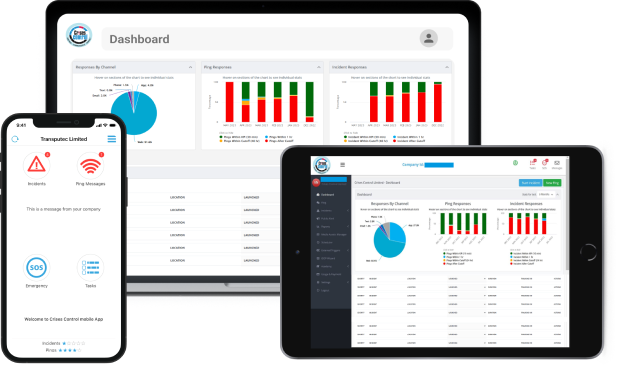Written by Shalen Sehgal | CEO
An emergency response plan (ERP) is a critical component of any organisation’s crisis management strategy. It outlines the steps to be taken in the event of a disaster, whether natural or man-made, to ensure the safety of employees and minimise disruption to business operations.
In this blog post, we’ll explore the 10 essential elements of an effective emergency response plan and how Crises Control, a leading crisis management software, can help streamline these elements.
The Importance of an Emergency Response Plan
An effective emergency response plan is critical for any organisation for several key reasons:
- Protect Employees and Minimise Harm: The primary purpose of an emergency response plan is to protect the safety and wellbeing of employees during a crisis. It outlines clear procedures for evacuation, sheltering, and emergency medical response to minimise injuries and loss of life.
- Mitigate Damage and Business Disruption: A well-designed emergency plan can help organisations quickly contain the impact of a disaster, whether natural or man-made. This reduces damage to facilities, equipment, and other assets, allowing the business to resume operations more quickly.
- Ensure Regulatory Compliance: Many jurisdictions have laws and regulations requiring organisations to have emergency preparedness and response plans in place. Failing to comply can result in fines and other penalties.
- Demonstrate Duty of Care: An emergency response plan shows employees and stakeholders that the organisation takes their safety and security seriously. This can enhance trust, morale, and the company’s reputation.
- Enable Effective Crisis Management: When a crisis strikes, an emergency plan provides a structured framework for coordinating the response, assigning responsibilities, and making critical decisions under pressure. This improves the overall effectiveness of the organisation’s crisis management.
By investing in a comprehensive emergency response plan, organisations can protect their most valuable asset – their people – while also safeguarding their operations, reputation, and long-term viability. This makes emergency preparedness an essential part of any robust business continuity strategy.

Improve Your EHS Management
Cultivate a culture of safety and simplify compliance with our comprehensive EHS solutions designed to protect your workforce and your business.
The 10 Essential Elements of an Effective Emergency Response Plan
An emergency response plan (ERP) is a critical component of any organisation’s crisis management strategy. In this section, we’ll explore the 10 essential elements of an effective emergency response plan and how Crises Control can help streamline these elements.
1. Risk Assessment
The first step in creating an effective ERP is to conduct a thorough risk assessment. This involves identifying potential threats and vulnerabilities specific to your organisation, such as natural disasters, cyber attacks, or workplace violence. By understanding the likelihood and potential impact of these risks, you can prioritise your response efforts and allocate resources accordingly. Crises Control provides a centralised platform for managing risk assessments, allowing you to document potential threats, assess their impact, and develop mitigation strategies.
2. Clear Communication Protocols
Effective communication is crucial during a crisis. Your ERP should include clear protocols for internal and external communication, specifying who is responsible for communicating with employees, customers, and stakeholders. Crises Control’s emergency notification system allows you to send alerts, updates, and instructions via SMS, email, voice calls, and mobile app, ensuring that everyone receives critical information in a timely manner.
3. Evacuation and Shelter-in-Place Procedures
In the event of an emergency, your employees need to know how to evacuate the premises safely or shelter in place, depending on the situation. Your ERP should include detailed evacuation routes, assembly points, and shelter locations. It should also specify how to account for all employees and visitors. Crises Control’s evacuation management feature helps you create and practice evacuation plans, track employee safety, and identify areas for improvement.
4. Roles and Responsibilities
An effective ERP requires a well-defined chain of command and clear roles and responsibilities for each member of the emergency response team. Your plan should specify who is responsible for activating the ERP, coordinating the response efforts, and communicating with first responders. Crises Control’s incident management module allows you to assign tasks, set priorities, and track progress in real-time, ensuring that everyone knows their role and is working towards a common goal.
5. Emergency Response Team Training
Regular training is essential to ensure that your emergency response team is prepared to handle a crisis. Your ERP should include a training schedule and specify the type of training required for each team member. Crises Control provides a centralised repository for storing training materials, tracking attendance, and assessing team readiness.
6. Business Continuity Planning
In addition to ensuring the safety of your employees, your ERP should also include measures to maintain business continuity in the event of a crisis. This may involve identifying critical business functions, establishing backup systems, and developing alternative work arrangements. Crises Control’s business continuity management software helps you identify critical processes, develop contingency plans, and track the impact of a crisis on your operations.
7. Incident Command System
The Incident Command System (ICS) is a standardised approach to managing emergency incidents. Your ERP should be aligned with the ICS and specify how your organisation will interface with local, state, and federal emergency management agencies. Crises Control’s incident management module provides a common operating picture for all stakeholders, allowing you to share information, coordinate response efforts, and maintain situational awareness.
8. Recovery and Restoration
Your ERP should include a plan for recovering from the crisis and restoring normal business operations. This may involve repairing damaged facilities, restoring critical systems, and providing support to affected employees. Crises Control’s incident management module helps you track the progress of recovery efforts, identify bottlenecks, and allocate resources effectively.
9. Testing and Exercises
Regular testing and exercises are essential to ensure that your ERP is effective and up-to-date. Your plan should include a schedule for conducting drills, tabletop exercises, and full-scale simulations. Crises Control provides a platform for creating and managing exercises, allowing you to assess your team’s readiness, identify areas for improvement, and document lessons learned.
10. Continuous Improvement
Finally, your ERP should include a process for continuous improvement. This involves regularly reviewing and updating the plan based on lessons learned from exercises, actual incidents, and changes in the organisation or external environment. Crises Control’s incident audit feature helps you track changes to your ERP, analyse incident data, and identify opportunities for improvement.
Conclusion
An effective emergency response plan is essential for any organisation that wants to protect its employees, maintain business continuity, and minimise the impact of a crisis. By incorporating these 10 essential elements into your ERP and leveraging Crises Control’s crisis management software to streamline these elements, you can ensure that your organisation is prepared for any eventuality.
If you’re interested in learning more about how Crises Control can help you create an effective emergency response plan, request a free personalised demo today.
Request a FREE Demo

